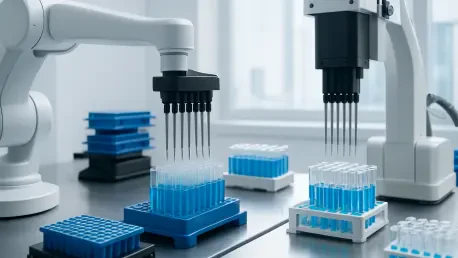The lab automation market is poised for a remarkable ascent, with forecasts projecting its value to soar to $12.5 billion by 2035, driven by a steady compound annual growth rate (CAGR) of 7.15% over the coming decade. This surge underscores a growing dependence on automated technologies to revolutionize laboratory operations across the globe. From cutting-edge research hubs to critical diagnostic centers, automation is emerging as a cornerstone of efficiency, tackling the urgent need for precision and speed in an era of escalating demands. The ability of these systems to streamline workflows and reduce errors positions them as indispensable tools in modern science and healthcare.
This growth is fueled by a confluence of factors, including the mounting pressure on labs to handle an ever-increasing volume of tests while maintaining stringent quality standards. Automation addresses these challenges by minimizing human intervention, enhancing productivity, and delivering consistent outcomes. Moreover, the backdrop of rising healthcare costs pushes facilities to adopt cost-effective solutions that can keep pace with demand without compromising reliability. As technology continues to evolve, the lab automation sector stands at the forefront of innovation, promising transformative impacts on how scientific and medical processes are conducted worldwide.
Market Drivers and Emerging Trends
Key Growth Factors
The escalating number of laboratory tests performed globally serves as a primary catalyst for the expansion of lab automation. With diagnostic and research demands skyrocketing, labs face the challenge of processing vast quantities of samples swiftly and accurately. Automated systems provide a robust solution, enabling high-throughput capabilities that manual processes simply cannot match. This is particularly critical in clinical settings where timely results can directly influence patient outcomes. Beyond sheer volume, the drive for standardization across workflows further propels the adoption of these technologies, ensuring reproducibility and compliance with regulatory benchmarks that are non-negotiable in today’s environment.
Another significant driver is the substantial increase in research and development spending within the pharmaceutical sector. As companies race to innovate and bring new drugs to market, the complexity and scale of experiments necessitate advanced automation to accelerate discovery phases and optimize testing protocols. This trend is amplified by the need to manage intricate data sets and repetitive tasks that, if handled manually, could slow progress and introduce errors. The integration of automated solutions not only boosts efficiency but also allows researchers to focus on strategic analysis rather than operational bottlenecks, thereby fostering a more dynamic and innovative R&D landscape.
Technological Innovations
At the heart of lab automation’s growth lies a wave of technological advancements that are redefining operational paradigms. Artificial intelligence (AI) and big data analytics are leading the charge, empowering labs to harness predictive insights and refine processes in real time. These tools enable the interpretation of complex data patterns, which can optimize everything from sample analysis to resource allocation. Such capabilities are proving invaluable in environments where precision is paramount, offering a glimpse into a future where decision-making is increasingly data-driven and less reliant on human guesswork.
Robotics, too, plays a pivotal role in this transformation, with automated systems like robotic arms and liquid handling instruments taking over repetitive and time-intensive tasks. This shift not only enhances accuracy but also frees up skilled personnel to engage in higher-value activities such as experimental design and results interpretation. Additionally, the advent of microfluidic technologies marks a significant leap forward, allowing labs to work with smaller sample volumes while reducing reagent costs. This miniaturization supports high-throughput analysis, a critical component for advancements in personalized medicine and diagnostics, ensuring that labs can meet modern demands with agility and efficiency.
Market Segmentation and Regional Insights
Segmentation by Type and Use
The lab automation market is characterized by diverse segments, each catering to specific operational needs and contributing to overall growth. Continuous flow processes stand out as a dominant category, prized for their ability to handle large sample volumes with seamless efficiency. This approach is particularly favored in industries where high-quality, rapid analysis is essential, such as clinical diagnostics and large-scale research. The prominence of continuous flow systems reflects a broader trend toward scalability, as labs seek solutions that can adapt to fluctuating workloads without sacrificing performance or reliability.
In terms of automation types, modular systems are gaining traction due to their inherent flexibility. Unlike total automation setups that can be rigid and costly, modular solutions allow labs to customize configurations by mixing and matching components to suit specific processes. This adaptability is a boon for facilities with varied or evolving needs, offering a cost-effective entry point into automation. Meanwhile, clinical chemistry analysis leads among end-use applications, driven by the critical role of automation in sample handling, storage, and labeling. The precision and integration offered by these systems are vital for maintaining data integrity, a cornerstone of clinical workflows that directly impacts diagnostic accuracy.
Regional Dynamics
North America currently holds a commanding position in the lab automation market, underpinned by substantial investments in healthcare and a regulatory environment that encourages technological adoption. This region benefits from a well-established infrastructure and a strong focus on innovation, which together facilitate the rapid integration of automated systems into lab operations. The significant revenue share captured by North America highlights its role as a pacesetter, setting benchmarks for quality and efficiency that influence global standards and practices in the industry.
In contrast, the Asia Pacific region is emerging as a powerhouse of growth, with projections indicating the fastest expansion in the coming years. Fueled by rising healthcare investments and burgeoning research and development activities, countries like China and India are becoming focal points for market opportunities. The expansion of healthcare infrastructure in these nations, coupled with a growing emphasis on modernizing lab capabilities, positions the region as a critical area for future investments. This dynamic underscores the importance of tailored strategies to navigate local challenges, such as funding constraints and skill gaps, while capitalizing on the vast untapped potential that exists.
Competitive Landscape and Future Outlook
Industry Players and Strategies
The competitive landscape of lab automation is marked by intense innovation and strategic maneuvering among leading players like Thermo Fisher Scientific and Agilent Technologies. These companies are prioritizing the development of cutting-edge products and forging partnerships to maintain their edge in a rapidly evolving market. Collaborations that integrate robotics with sophisticated instrumentation are setting new standards for lab efficiency, as seen in recent alliances aimed at enhancing workflow automation. Such initiatives reflect a broader industry commitment to addressing complex challenges through shared expertise and resources.
Beyond product innovation, a key focus for market leaders is the provision of comprehensive customer support and training programs. Recognizing that the effectiveness of automation hinges on user proficiency, companies are investing in user-friendly interfaces and educational resources to ensure seamless adoption. This customer-centric approach not only boosts satisfaction but also fosters long-term loyalty in a sector where trust and reliability are paramount. As competition intensifies, the ability to offer tailored solutions and robust after-sales services will likely distinguish the frontrunners from the rest, shaping the market’s trajectory in significant ways.
Path Forward for Stakeholders
Looking ahead, the lab automation sector presents a wealth of opportunities for stakeholders to drive progress and address lingering challenges. Labs must prioritize strategic investments in automation to stay competitive, focusing on scalable solutions that can evolve with technological advancements and workload demands. Manufacturers and solution providers, on the other hand, should double down on innovation, exploring ways to integrate emerging technologies like AI and robotics into accessible, cost-effective systems that cater to diverse lab environments.
Equally important is the role of policymakers and regulators in creating an enabling environment for automation adoption. By addressing barriers such as high upfront costs and skill shortages through incentives and training initiatives, they can accelerate the widespread implementation of these technologies. The path forward also calls for a concerted effort to bridge regional disparities, ensuring that emerging markets gain access to the tools and expertise needed to modernize their lab operations. Reflecting on the strides made, the industry’s journey thus far demonstrates a relentless pursuit of efficiency and quality, setting the stage for a future where automation continues to redefine the boundaries of scientific and medical achievement.









